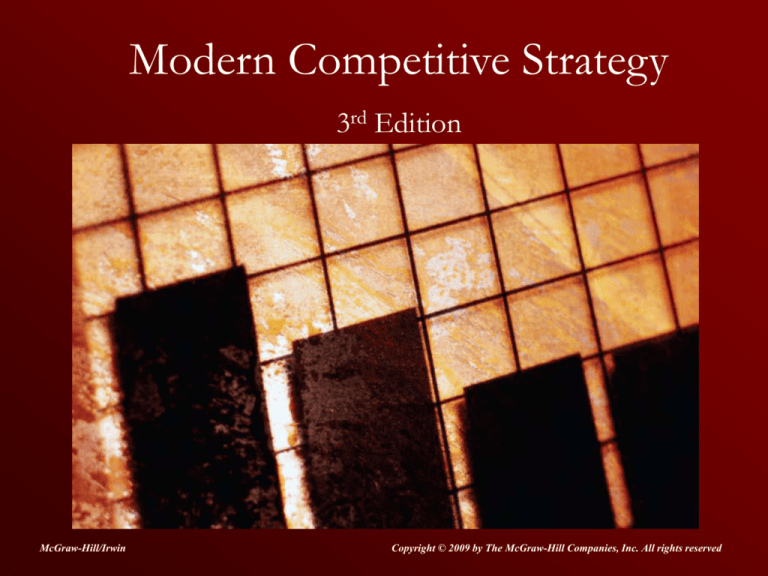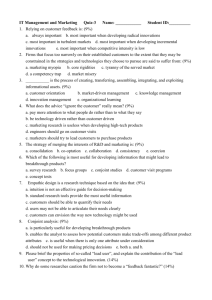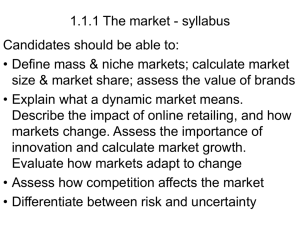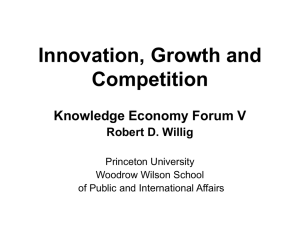
Modern Competitive Strategy
3rd Edition
McGraw-Hill/Irwin
Copyright © 2009 by The McGraw-Hill Companies, Inc. All rights reserved
Chapter 5
Competing Over Time
5-2
Three Stages of Industry Growth
Growth
Shakeout
Exit rate exceeds the entry rate
Maturity
Entry rate exceeds the exit rate
Entry and exit rates are about the same
Industry disruption
Technological substitutes or disruptive technologies offer a
stronger buyer surplus to the industry’s customers, drawing
them away (e.g., DVDs vs. videotapes)
5-3
Industry Evolution
All industries evolve over time as new firms enter and
failing firms exit
Industry evolution threatens all sources of competitive
advantage
The more a firm resists the forces of industry evolution,
the less likely it is to survive
Product life cycle
Not the same as industry evolution but often linked closely to it
5-4
Number of Years in Each Developmental Stage for Selected
Industries from the Inception of the Industry until 1981
Source: Excerpted from Steven Klepper and Elizabeth Graddy, “The Evolution of New Industries
and the Determinants of Market Structure,” RAND Journal of Economics 21, no. 1 (1990)
Table 4.1
5-5
Number of Firms Remaining at the End of
Stages 1 and 2 for Selected Industries
Source: Excerpted from Steven Klepper and Elizabeth Graddy, “The Evolution of New Industries
and the Determinants of Market Structure,” RAND Journal of Economics 21, no. 1 (1990), p. 32.
Table 4.2
5-6
The Industry Life Cycles of Four Representative Industries
Guided Missiles
Nuclear Reactors
1
Standardized Values
Standardized Values
1
0.8
0.6
0.4
0.2
0.8
0.6
0.4
0.2
0
0
0
10
20
30
0
40
10
Year from Birth of Product
Exit
Entry
30
40
Year from Birth of Product
Exit
Number
Entry
Number
Radiant Heating Baseboards
Paints
1
Standardized Values
1
Standardized Values
20
0.8
0.6
0.4
0.2
0
0.8
0.6
0.4
0.2
0
0
10
20
30
40
50
60
0
Exit
Entry
10
20
30
40
50
Year from Birth of Product
Year from Birth of Product
Number
Exit
Entry
Number
5-7
Entries, Exits and Total Firms in the U.S.
Automobile Industry 1880-1974
5-8
Total Production of U.S. Automobile Firms
(in millions)
5-9
Total Automobile and Model T Production,
1909-1927
5-10
Dynamic Growth Cycle
Firm Size
Innovation in Processes
or Products
Improved Market Position
Through Higher Value,
Lower Cost or Both
Capacity
Expansion
Increased
Profitability
Figure 4.1
5-11
Key Concepts in Developing and Maintaining
Dynamic Capability
Dynamic growth cycle
Dynamic capability
The cycle of firm growth linking size, innovation, productivity,
profitability, and capacity expansion
The ability of a firm, as it grows, to build its innovative
potential and exploit it effectively
Path dependence
The tendency of a firm over time to invest in innovations that
are upwardly compatible with each other, thereby creating a
relatively unique path of product and process development
5-12
Key Concepts in Developing and Maintaining
Dynamic Capability (cont’d)
Absorptive capacity
The ability of the firm to adopt innovations developed
by other organizations based on its prior experience
with similar or related practices or technologies
Core rigidity
The inability of a firm to adapt to changing market or
technological conditions because of its attachment to its
core practices and customers
5-13
Samsung’s Virtuous Cycle in 2003
Investment Ahead
of the Competition
Cash Flows and
Balance Sheet Flexibility
Market Leadership
High Profits
5-14
Customer Segmentation over the Product
Life Cycle
5-15
Expansion During the Growth Stage
Developing scale-based value drivers
Which drivers are adopted depends on the purchasing
criteria of the majority of buyers
For example: brand, service, network externalities, quality
Moving from early adopters to the early majority is crossing
the chasm
Developing scale-based cost drivers in specific value
chain activities
Economies of scale
Economics of scope
Learning curve
5-16
Early Mover Advantage
Defined by a combination of competitive
advantage (short term) and dynamic capability
(long term)
Opportunity to establish and defend a strong
market position
Opportunity to grow over a longer period of time
Higher chances of being exposed to opportunities
for growth and innovation
5-17
Strategic Pricing
Strategic pricing
Pricing below marginal cost in order to attract additional
buyers
Strategic pricing makes sense under two conditions
When increases in volume are sustainable through customer
loyalty due to higher switching costs
When increased demand leads to lower costs for the firm
through scale-driven cost drivers such as the learning curve and
scale economies
5-18
Risks of Strategic Pricing
Cost reduction due to learning or scale does not make up
for the profits lost by setting a lower price
Poor understanding of technologies or other activities
Inability to protect cost advantages
Higher demand does not materialize
Customers cannot be retained
5-19
What Determines a Shakeout?
Shakeout
Due to the emergence of a dominant, sustainable business model (value
minus cost)
The strongest competitors use their higher productivity to drive out weaker
firms
Shakeouts can occur in the same time frame
As the product life cycle shifts toward maturity
The product life cycle does not explain which firms will survive the
shakeout
As a dominant design emerges
A dominant design is the culmination of a series of innovations in a
product’s components and architecture and in related value drivers, such
as service, network externalities, complements, or breadth of line
For example, the IBM PC, the general purpose tractor, the piano
5-20
Rates of Product and Process Innovation
over the History of the Industry
Source: Adapted from James Utterback, Mastering the Dynamics of Innovation,
(Cambridge, MA: Harvard Business School Press, 1994), p. 82.
Figure 4.3
5-21
What Determines a Shakeout’s
Severity?
Expectations about future market demand and the
degree of sunk costs
Ease of imitation of the dominant firms’ market
position
The existence of defendable niche markets
About six percent of the firms in an industry exit
during the shakeout every year
5-22
Indicators of Industry Maturity
The long-term leveling-off or decline in the market
growth rate
Rising buyer experience with industry products
The high concentration of market share among large,
relatively similar firms
The persistence of niche markets
5-23
An Increase in Buyer Experience
Firms attempt to counter the growing power of
experienced buyers by:
Introducing innovations that increase search and transition
costs for buyers:
Improved service
Higher quality
Breadth of line and product customization
Lowering prices
5-24
Industry Concentration
Industry concentration depends on
The ratio of market size to the minimum scale required to
compete
The lower the scale, the more firms are viable
Sunk cost investments in value drivers that have increasing
returns to scale
Higher sunk costs force out smaller rivals and deter entry
5-25
Hypercompetition
Hypercompetition is the combination of:
Multipoint competition
Industries in which large firms compete across many products in
a product line and across geographical regions
Mutual footholds in the core market of rival firms ensure
competitive stability
An arms race
The requirement to develop product and process innovations to
keep up with competitors
Returns on innovations become lower innovations are copied by
competitors
5-26
Niche Markets
Competition in niche markets is affected by:
Size of the niche
Growth rate of the niche
Barriers to entry
Changes in niche buyers’ preferences toward core market
products
Minimum level of scale required to compete
Ability to improve non-scale based cost and value drivers
Increase in the buyer switching costs
5-27
Types of Industry Disruption
Technological substitution
Introduction of a radically new technology that has a higher
rate of return on investment in R&D than the current
technology in the industry
Disruptive innovation
Introduction of a new product with lower value but much lower
cost than the incumbent product
Typically based on standard components
Exploits emergent customer price sensitivity
Radical institutional change
A radical shift in the regulation of competition that opens the
market to firms with innovative capabilities
5-28
Adapting to Industry Disruption
When can incumbents adapt to disruption?
When they control assets (e.g., distribution) that are critical for
competing in the industry
When isolating mechanisms protecting the innovation are weak
When incumbents do not suffer large short-term opportunity
costs in switching to the innovation
5-29
Industry Disruption from Technological
Substitution
Figure 4.5
5-30
Trends in VCR and DVD sales in the United
States by quarter, 1998-2003
Figure 4.6
5-31
Incumbents Adaptation to
Technological Substitutes
Incumbents delay adopting technological substitutes for
the following reasons
Emphasis on total (rather than marginal) return on investment
in R & D
Potential cannibalization by the new technology of profits from
the traditional technology
Poor absorptive capacity to adopt new technology
5-32
Disruptive Technology
Characteristics include:
Technology initially introduced by start-ups into niche
market too small to attract incumbents’ attention
Product based on technology has relatively lower initial
functionality and also a lower cost
Price-value profile of new product does not initially attract
customers in industry’s core market
5-33
Disruptive Technology (cont’d)
Over time, preferences of incumbents’ customers shift toward
value-price profile of new product
Complementary assets (distribution) necessary for market
penetration of disruptive technology not controlled by
incumbents
Start-ups selling new product develop a dynamic growth cycle
which allows them to penetrate core market rapidly through
scale-based cost drivers
5-34
Disruption by Regulatory Change
Deregulation typically leads to:
Entry
Industry consolidation
Decline in incumbents
Table 4.4
5-35











